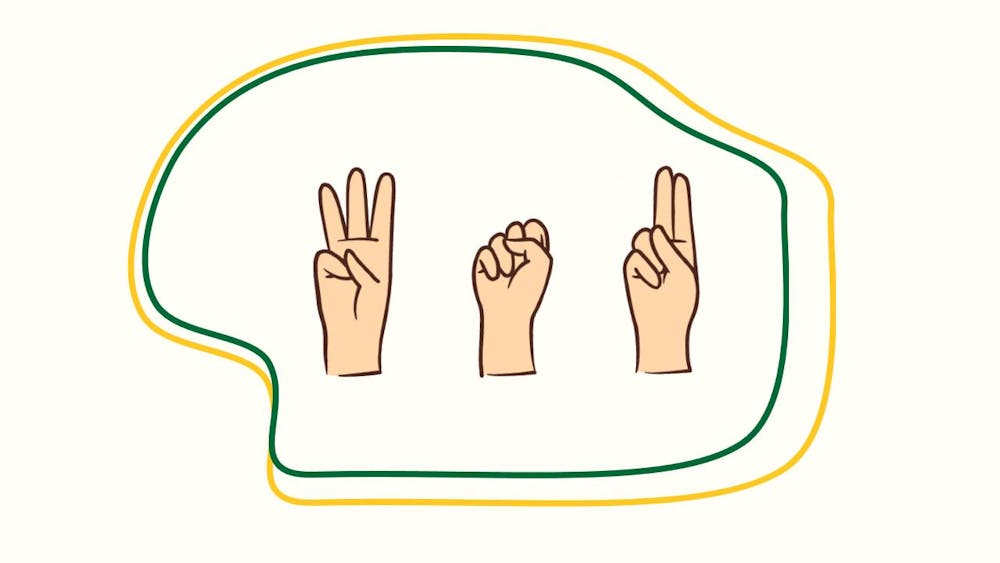Recently, there have been some cancelled ASL classes at Wright State University, leading to rumors that the program is being phased out. This has caused concern for those who love the program, and more importantly, for those who rely on it. However, after looking deeper, it turns out that it is not what it seems.
A brief introduction to American Sign Language
“Introduction to Deaf Culture” is a textbook written by Thomas K. Holcomb, which briefly explores all the elements that go into any culture, particularly focusing on how they function within the richness of Deaf culture.
“Because ASL was developed by Deaf people themselves and has evolved over the years, it is culturally bound to the Deaf community and has the power to express thoughts, feelings, and ideas that are critical to the Deaf existence,” Holcomb wrote.
While some people still hold prejudice against Deaf and hard of hearing people, also known as audism, those few who hold the belief that ASL does not count as a language remain objectively ignorant.
“The Language Files: Thirteenth Edition” is another textbook used to teach linguistics, which was worked on by a large variety of authors and editors, and was ultimately published by Ohio State University’s department of linguistics.
“Human languages can also be visual-gestural, which may also be referred to as signed languages. Visual-gestural languages, hundreds of which are in use all over the world, are perceived visually and produced via hand and arm movements, facial expressions, and head movements,” “Language Files” says.

ASL is a full language, conveyed visually rather than audibly. It is complex in its visual nature, which is far more accessible to Deaf and hard of hearing people.
“Deaf people in America are best described as being bilingual because they use at least two languages, ASL and English, in their daily lives, both within the Deaf community and in mainstream society,” Holcomb wrote.
ASL and WSU
For a long time, students have loved WSU’s thriving ASL program. Staff and students share a strong, passionate community dedicated to the program.
Heather Emmert, a WSU student majoring in social work with a double minor in Deaf studies and healthcare communications, has known since childhood that she had hearing loss and was hard of hearing. However, through the ASL classes she took at WSU, she discovered she was Deaf.
“I learned I was part of the community last January in my first ASL class. There are several other students that have had the same revelation this semester and others,” Emmert said.
Emmert is grateful to the ASL program at WSU because it has given her a true community, as well as another language with which she can better communicate.
“Cutting this program would confirm that my experiences and the experiences of other hard of hearing students don’t matter beyond the dollars we can bring in,” Emmert said. “To take that away would rob other students of the opportunity to know that there is a language that provides us better communication access.”
Luckily for students, the program does not seem to be going anywhere.
Addressing the (false) rumor
Barb Dunaway is the director of ASL and Sign Language Interpreting at WSU. When she was asked about the rumor that had sprung up around students, seemingly stemming from a certain ASL class, Dunaway was surprised.
“We have not heard that the program is being closed. And, in speaking with my Department chair, it is not on her radar either,” Dunaway said.
While the rumor was baseless, it was thought to be supported by the cancellation of some ASL classes this semester, but Dunaway addressed that as well.
“There were several classes that had to be cancelled this semester, but that was due to a faculty member leaving [WSU] at the last minute and not being able to fill that teacher position before the beginning of the semester. There is not enough time in my day for me to teach all of the classes that were on the schedule. So, I compromised and am teaching two sections of ASL 1010 and two sections of ASL 1020,” Dunaway said.
Taking on a much larger workload than usual, Dunaway and her fellow ASL staff are happy with the program and the way it is thriving, and are happy to set things straight.
With this news, students should be happy to know that the program is not going anywhere. Those interested in taking the courses should visit WSU’s course registration page; otherwise, get used to the ASL program sticking around!











